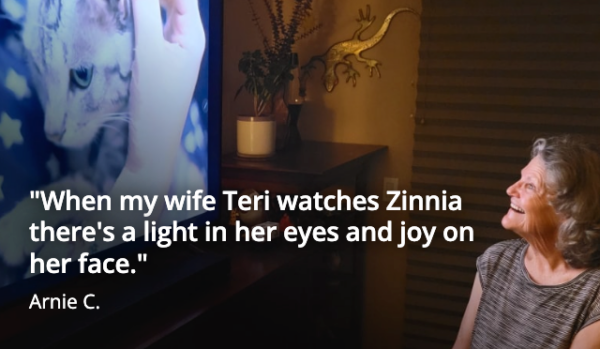A Dementia Caregiver Creates the Solution She Wishes She’d Had

My sweet husband, Evan, was 47 years old when he was diagnosed with frontotemporal dementia. Our kids were 12 and 15. I could write volumes describing what life was like at that time, but I will instead sum it up here in just three words: chaos, uncertainty, tears. Lots of tears.
I quickly came to learn that if we, as a family, were to have any kind of quality of life, and if the kids and I were to pop out the other end relatively intact, I needed community, education, skills, and tools. I joined a support group. (Note: if you are a dementia caregiver and you are not yet a member of a support group, put that at the very top of your to-do list.) I did research and watched videos online. I learned about my husband’s condition and built skills to better care for him AND myself and the kids. And I made plenty of mistakes, which I learned from, too.
When the clash between a man with dementia and young teenage boys and a worn-out wife got to be too much, Evan moved into long-term care. Guilt. Despair. Relief.
I visited him regularly and witnessed a troubling trend. The television in the common area was always on. He was often parked in front of it. And the programming he was forced to endure was torturous. The weather channel. Sitcoms. Movies from the 1940s and 1950s. And once, the movie Kill Bill. He had lost the ability to get out of a chair unassisted, so he was truly trapped. And he was bored. He was agitated. He was often asleep or staring around the room.
I got angry. Nobody should be parked in front of a TV for hours on end. I also got curious. If TV was going to be an unavoidable part of daily life in the care community, wasn’t there something out there better than CNN? The short answer was this: precious little. There were things like slow-paced videos of animals on YouTube, but they were usually not high quality, and the commercials were a real problem. There was nothing purposefully built for people with dementia.
Research helped me understand why regular TV was so inappropriate, especially for people in mid- to late-stages of dementia. It requires that the viewer be able to track a plot, tell fact from fiction, process rapidly moving audio and video—all skills my husband had lost.
I started making my own videos using Apple’s Memory product on my iPad. Slow paced. Set to soothing music. High-value content—our dog, our cat, our kids. My husband paid rapt attention to them. But I wanted more content; content that was not on my iPad. And I wanted enough of it that I could offer it to the care community as an alternative. Slow-paced, dialogue-free videos of skiing, maybe. Or mountain biking. Paris. Things my husband had loved as a healthy man. I wondered if there was a way to produce these “dementia-friendly” videos using content from other sources. And if my husband enjoyed them, would other caregivers welcome the ability to share them with their own beloveds?

To watch Zinnia, go to www.zinniatv.com or your app store to download a free trial. A family subscription costs just $6.99/month or $69.99/year. You can also try Zinnia for free on the Zinnia YouTube channel.
I wrangled an introduction to Frank Lee, who was part of the design team for Apple’s Memory product. I told him how I was using it. Frank got excited. He loved the idea. And he had just left Apple and was looking for his next gig. We teamed up, added a couple more key people and produced Zinnia, an app for mobile devices and connected TVs.
Our company was named for the Zinnia flower that flourishes even in horrible conditions. The dream was to build a library of content that would help people with dementia and their caregivers thrive beyond their diagnosis.
My initial interest was to produce research-driven content engaging for and digestible by people with dementia. How cool would it be to keep them involved long enough for a caregiver like me to peel a carrot, wash my hair, or drive a kid to a wrestling match?
What we have created with Zinnia is that and so much more! Our library now consists of over 250 videos organized into categories like Nature, Places, Interests, Animals, Fun and Games. These videos can be watched alone or with a caregiver and serve as powerful conversation starters or opportunities for respite.

: “Let’s Drink Water” is among the videos designed to encourage a person living with dementia to participate in activities of daily life.
We receive heartwarming testimonials from caregivers who rely on a favorite video like Babies First Year, or Classic Cars to help soothe a person reacting to anxiety or confusion. We’re very proud of a channel called Activities of Daily Living. Here, we host videos like Let’s Drink Water, Let’s Get Dressed, and Let’s Use the Toilet. These have proven to be game changers for caregivers who have difficulty encouraging a family member to participate in activities of life. “Look Dad! Everyone is drinking water. Even the kitty cat. Maybe we should, too!”
We also have content just for the caregiver—videos to familiarize them with Zinnia and how to make the most of it. And videos to help them better understand this thing called dementia, with titles like Dementia and Communication, Tips for Medication Refusal, and When to Stop Driving.
With Zinnia, we’ve built the tool I needed back when I was a dementia caregiver. We lost Evan in 2019 when Zinnia was still just a seedling. I know he would have loved it. As for myself and the kids, I’m happy to report that we seem to have pretty much popped out the other end of this thing intact.
My heart goes out to all families working their way through a diagnosis. It is my sincere hope that Zinnia brings you some relief.
 Contributor Allyson Schrier is co-founder and president of Zinnia. She worked for three years at the UW Memory and Brain Wellness Center and lectures about dementia caregiving to family and professional caregivers. She is a member of the Washington State Dementia Action Collaborative. In 2020, Allyson was honored to receive a Maude’s Award, and was named Caregiving.com’s Visionary Caregiver of the Year.
Contributor Allyson Schrier is co-founder and president of Zinnia. She worked for three years at the UW Memory and Brain Wellness Center and lectures about dementia caregiving to family and professional caregivers. She is a member of the Washington State Dementia Action Collaborative. In 2020, Allyson was honored to receive a Maude’s Award, and was named Caregiving.com’s Visionary Caregiver of the Year.
![AgeWise King County [logo]](https://www.agewisekingcounty.org/wp-content/themes/agewisekingcounty/images/logo.png)